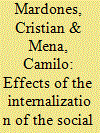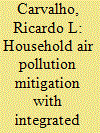|
|
|
Sort Order |
|
|
|
Items / Page
|
|
|
|
|
|
|
| Srl | Item |
| 1 |
ID:
177152


|
|
|
|
|
| Summary/Abstract |
In 2017, environmental taxes on global pollutants (CO2) and local air pollutants (SO2, NOX, and PM) began to be collected to reduce emissions in Chile. However, large emitting sources only are subject to environmental taxes and the tax rates are much lower than the social cost of these pollutants, which does not allow to fully internalize the generated damages. For the above, this study uses the environmental extension of the Leontief price model and microsimulations to estimate the economic, environmental, distributive, and poverty short-term effects associated with the application of Pigouvian taxes on all emissions generated by productive activities. The results show that currently there are too many resources allocated to activities that generate strong negative externalities, mainly in the electricity and transport sectors. Specifically, the emissions are reduced almost 10 times more than in the current tax scenario if environmental taxes equal to social costs are applied, but relevant negative indirect effects are generated that make the practical application of a tax of these characteristics unrealistic. For example, there is a fall between 1.2% and 2.9% in employment, slightly worsening the income distribution and increases the poverty rate between 0.9 and 2.3 percentage points.
|
|
|
|
|
|
|
|
|
|
|
|
|
|
|
|
| 2 |
ID:
166720


|
|
|
|
|
| Summary/Abstract |
Traditional cooking is today's largest global environmental health risk. Over 640 million people in Africa are expected to rely on biomass for cooking by 2040. In Kenya, cooking inefficiently with wood and charcoal persists as a cause of deforestation and household air pollution. This research analyses the effects of four biomass cookstove strategies on reducing air pollutant emissions in Kisumu County between 2015 and 2035 using the Long-Range Energy Alternatives Planning system. The Business as Usual scenario (BAU) was developed considering the historical trends in household energy use. Energy transition scenarios to Improved Cookstoves (ICS), Pellet Gasifier Stoves (PGS) and Biogas Stoves (BGS) were applied to examine the impact of these systems on energy savings and air pollution mitigation. An integrated scenario (INT) was evaluated as a mix of the ICS, PGS and BGS. The highest energy savings, in relation to the BAU, are achieved in the BGS (30.9%), followed by the INT (23.5%), PGS (19.4%) and ICS (9.2%). The BGS offers the highest reduction in the GHG (37.6%), CH4 (94.3%), NMVOCs (85.0%), CO (97.4%), PM2.5 (64.7%) and BC (48.4%) emissions, and the PGS the highest reduction in the N2O (83.0%) and NOx (90.7%) emissions, in relation to the BAU.
|
|
|
|
|
|
|
|
|
|
|
|
|
|
|
|
|
|
|
|
|